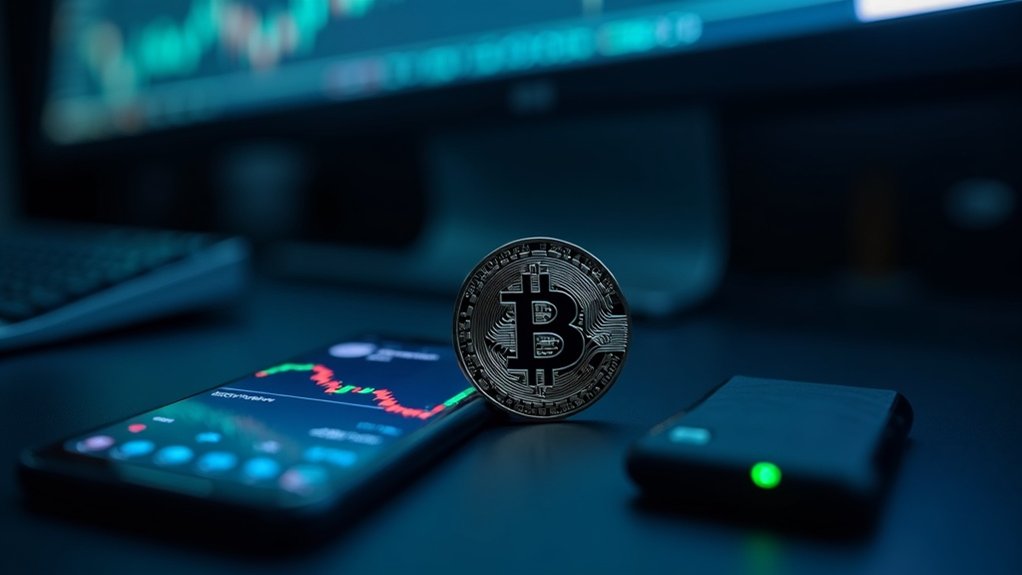A crypto fork happens when a blockchain splits into two competing paths because the network can’t agree on changes. Think of it as digital divorce. Soft forks tighten rules while staying compatible, but hard forks create entirely new cryptocurrencies. Sometimes it’s over scaling disputes, security fixes, or pure developer stubbornness. The result? Two separate chains sharing history but going different directions. Bitcoin Cash and Ethereum Classic prove these splits can get messy, permanent, and surprisingly profitable for some.
What happens when a blockchain can’t agree with itself? It splits. That’s a fork in crypto, and it’s messier than it sounds.
When blockchain consensus shatters, the network fractures into competing paths—creating digital chaos that makes corporate boardroom disputes look civilized.
A fork occurs when a blockchain literally splits into two competing paths.
Think of it as a software upgrade gone rogue.
These splits happen because decentralized networks don’t have a CEO making executive decisions.
Instead, they rely on consensus, and sometimes that consensus breaks down spectacularly.
There are several types of forks, each with their own drama.
Soft forks are the polite ones.
They’re backward-compatible updates that tighten rules without causing major disruption.
Old nodes can still participate, making soft forks feel like gentle nudges rather than sledgehammer blows.
Hard forks? They’re the nuclear option.
These create permanent splits, birthing entirely new blockchains and cryptocurrencies.
When a hard fork happens, the blockchain community effectively says “we can’t work together anymore” and goes their separate ways.
It’s like a messy divorce, but with digital money.
Then there are accidental forks.
These happen when two miners create blocks simultaneously at the same height.
Usually temporary, they get resolved through normal consensus mechanisms.
Think of them as awkward miscommunications that sort themselves out.
Codebase forks are different entirely.
Developers copy existing blockchain code and modify it to create something new.
It’s perfectly legal in the open-source world, though it can flood the market with copycat cryptocurrencies.
Why do forks happen?
Disagreements, mainly.
Communities and developers clash over scaling, security fixes, or fundamental rule changes.
Sometimes it’s about reversing catastrophic bugs or fraudulent transactions.
Other times, it’s pure stubbornness.
Protocol upgrades get formally proposed through numbered improvement proposals that allow the community to democratically evaluate changes.
The consequences can be significant.
Hard forks create two separate cryptocurrencies sharing common history but following different rules.
Bitcoin Cash emerged from Bitcoin scaling disagreements.
The historic DAO hack led to Ethereum’s most significant fork, creating two distinct chains with different philosophies about immutability.
Ethereum Classic exists because some folks refused to accept Ethereum’s response to the DAO hack.
The 2010 Bitcoin fork reversed transactions to fix a critical bug, proving that even Bitcoin isn’t immune to dramatic course corrections.
Forks can improve functionality, security, and scalability.
They allow blockchain evolution without destroying existing systems.
However, they also create network fragmentation, user confusion, and reduced consensus.
Success depends on community support, developer engagement, and market acceptance.
Multiple chains can coexist indefinitely.
Ethereum, Ethereum 2.0, and Ethereum Classic all exist simultaneously, each serving different purposes and communities.
Forks represent both blockchain technology’s flexibility and its occasional inability to play nice with itself.
Many cryptocurrency forks face varying tax treatment across jurisdictions, with some tax authorities classifying permanent splits as taxable airdrops.
Frequently Asked Questions
Can Fork Failures Cause Investors to Lose Their Cryptocurrency Holdings Permanently?
Yes, fork failures can permanently destroy cryptocurrency holdings.
When exchanges don’t support new forked currencies, investors get zilch. Users holding private keys in incompatible wallets? Their forked assets vanish forever.
Hard fork upgrades gone wrong isolate users from networks, making coins worthless. Malicious forks create theft vulnerabilities.
Poor coordination leads to irreversible errors during changes.
Bitcoin Cash and Ethereum’s DAO fork proved this reality—some investors lost funds permanently through replay attacks and botched implementations.
How Long Does It Typically Take for a Blockchain Fork to Complete?
Fork completion time depends entirely on the type.
Temporary forks? Minutes. They resolve fast when the longer chain wins.
Soft forks take days to weeks since they’re backwards-compatible.
Hard forks? That’s where things get messy.
Weeks to months of developer coordination, community drama, and miner politics.
The proposal phase alone drags on forever with endless debates.
Then there’s testing, deployment, monitoring.
Basically, the more controversial the fork, the longer everyone argues about it.
Do All Cryptocurrency Exchanges Support Newly Forked Coins Immediately After Creation?
No, exchanges definitely don’t support newly forked coins immediately.
Most take their sweet time evaluating technical risks, legal compliance, and whether the fork is even worth bothering with.
Some exchanges credit users automatically, others make them jump through hoops, and many just ignore forks entirely.
Engineering secure wallet infrastructure for every random fork is expensive and complicated.
Users wanting immediate access better move their coins to private wallets first.
What Happens to Smart Contracts During a Hard Fork Implementation?
Smart contracts get duplicated across both chains during hard forks, preserving their state up to the split.
After that? They operate independently on each chain.
New protocol changes can break older contracts or introduce fresh opcodes that alter gas costs.
Some legacy contracts might malfunction entirely.
Developers scramble to audit compatibility issues while users face potential replay attacks.
The London Fork added BASEFEE opcode, but not every upgrade plays nice with existing contracts.
Are There Tax Implications When Receiving New Coins From Blockchain Forks?
Yes, receiving forked coins typically triggers ordinary income tax when users gain “dominion and control” over them.
The taxable amount equals the fair market value at receipt.
Here’s the kicker: determining exactly when someone has control gets murky, especially with exchange-held tokens.
The IRS made this clear in Revenue Ruling 2019-24.
Later sales face capital gains treatment based on that initial FMV basis.
Record-keeping becomes essential, obviously.









